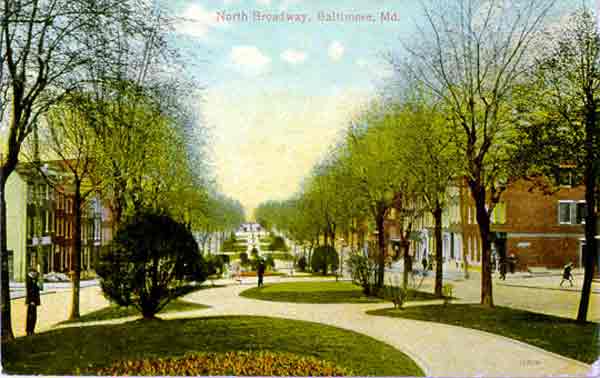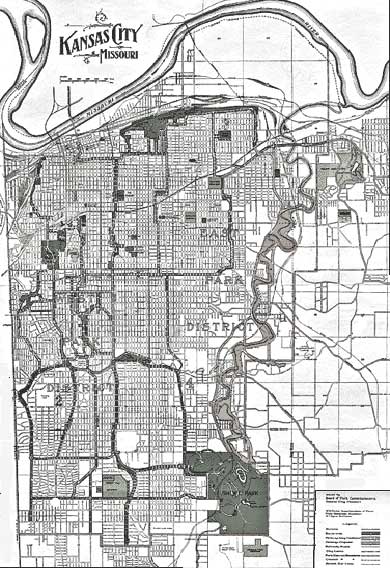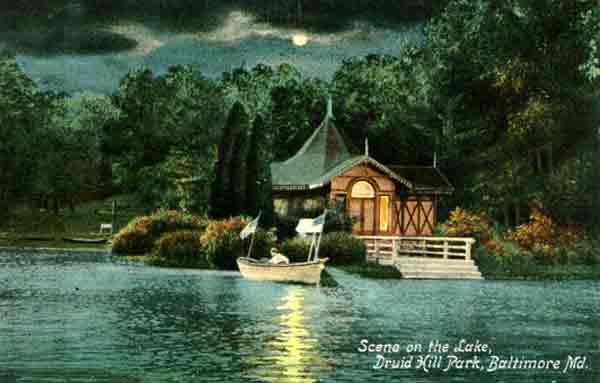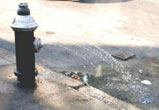

133 parks and boulevards
Outside New England, provisions for open space had always been haphazard at best. That region had its town greens or commons, and the idea spread with New England civilization across the southern shores of the Great Lakes; Cleveland, founded as a capital for Connecticut's Western Reserve in 1796, was laid out around a four-acre common that is now Public Square; the courthouse squares of innumerable Midwestern county seats continued the tradition. Most other cities managed at least one small central space with trees and landscaping, often surrounding or adjoining a public building, like City Hall Park in New York, or the capitol grounds of so many new state capitals. Beyond these, the idea of parks came in with considerations for the water supply in the 1830's and 40's: Philadelphia's Fairmount Park, still America's largest center-city park, began as land kept to protect the city's water supply along the Schuylkill River. As we have seen, much of the inspiration for new parks came from the cemeteries; Philadelphia hired the man who landscaped Laurel Hill Cemetery to do the job in Fairmount Park. Other early parks were made from the reservoirs themselves, surrounded by landscaped promenades; as they were constructed on heights, they usually had a nice view of the city, as with the bizarre, Egyptian revival Croton Receiving Reservoir in Manhattan, or Ridgewood Reservoir in Brooklyn. Most of these disappeared when advances in water technology made the reservoirs obsolete, and no one remembers them today; the site of the Croton Reservoir is now occupied by the New York Public Library. Infant Chicago, quite amazingly, became the leader in park planning, setting aside land for what would become downtown's Grant Park as early as 1840, and initiating the first system of boulevards in the 1860's. Lincoln Park and its southern counterpart Jackson Park had their beginnings at the same time, and the city set up three park district boards for them with the authority to issue bonds. Los Angeles, not amazingly, wasn't even a follower. Bequeathed a fine central plaza by the Spanish, the gringos sold off the land almost as soon as they grabbed control of the town. Besides Chicago, the one new city to do itself proud was a place few Americans had yet heard of. Portland, Oregon, at its founding in 1852, set aside a 25-block strip of its grid as 'Park Blocks'. The city would later sell off half of it, but what is left, in the North Park Blocks, survives as a downtown amenity few cities can match, at once wild and urbane, covered with firs and oaks of colossal Pacific Northwest proportions. If Oregonians are tree-huggers today, the vision provided by Portland's Park Blocks may have as much to do with it as the virgin forests beyond the pale. 
Still, the biggest, boldest and most sophisticated park plan took shape in New York. When the space dedicated for the 'Parade', the only large park provided for in the 1811 plan, was gobbled up by speculators, New Yorkers were moved to act. The campaign to create Central Park was led by, among others, Andrew Jackson Downing and the poet Stephen Cullen Bryant. The state legislature authorized the park in 1851 on an unprecedented scale. A competition was announced for its design in 1857, and the winner was a plan called 'Greensward', created by two Downing disciples, the city's new parks commissioner, Frederick Law Olmsted, and his collaborator Calvert Vaux. In works carried on continuously for 25 years, through the Civil War and beyond, the city pharaonically shifted five million cubic yards of earth and employed 160 tons of explosives to break up the hard outcrops of Manhattan's metamorphic schist. Downing had recommended an 'expressive, harmonious and refined imitation of nature', and that is exactly what Olmsted and Vaux gave them. Not nature, as in Portland, but a hugely expensive artistic composition, an imitation. Among the two partners, Olmsted was the true revolutionary. Farmer, horticulturalist, vagabond, journalist, he had tried everything in the course of an eventful but unsatisfying early life. A fortuitous appointment in New York opened the door, and a brilliant competition entry made his unexpected career as America's foremost landscape designer and city-builder. Olmsted was full of ideas. His youth had been spent in a declining New England, watching its sons and daughters slink off west or to the big towns. He could see that in the countryside, everywhere, economic prospects would grow increasingly dim, while in the cities, life hardly seemed real at all. A country boy, he was the first American to give serious thought to the future of urban communities. He had an angle on the essential problem, and to fix it he employed the tools he knew best, the things that were green and full of life. Olmsted's inspired hand sited groves, gardens, paths, lawns and rambles in just the right places between 59th and 110th, but that was only the beginning of his dream. Parks, as he understood them, were not simply aesthetic, but the only means of ameliorating city life. He once spoke of creating: '...at points so frequent and convenient that they would be an elevating influence on all the people, public parks and gardens, galleries of art and instruction in art, music, athletic sports and healthful recreations, and other means of cultivating taste and lessening that excessive materialism of purpose in which we are, as a people, so cursedly absorbed.' In later years, Olmsted got a kick out of walking in his New York parks, enjoying the 'modern' spectacle of all classes and nations having fun in them together: 'I have looked studiously but vainly among them for a single face completely unsympathetic with the prevailing expression of good nature and lightheartedness...Is it doubtful that it does men good to come together this way in the pure air and under the light of heaven , or that it must have an influence directly counteractive to that of the ordinary hard, hustling working hours of town life?'. Olmsted went on to create a fair helping of the jewels our cities can claim today: the Boston Fenway, Brooklyn's wonderful Prospect Park, Montreal's Mount Royal Park, Buffalo's Delaware Park. His example showed New York how to put land aside for future use, and so made possible Riverside and Morningside Parks in upper Manhattan, and all those that followed. Other cities were already catching on. Tower Grove Park in St Louis (1859) was laid out as an English and horticultural garden, the creation of a retailer and amateur horticulturalist named Henry Shaw on his own estate. Like this one, most of the others began as private estates and were later given or sold to the city. Baltimore's lovely Druid Hill Park came in 1867, San Francisco's Golden Gate Park in the 1870's-with pavilions and gates paid for and named for rich benefactors. In 1868, Olmsted began the first comprehensive system of parks and parkways for Buffalo. Others began as fairgrounds, especially in western cities (St Louis again, though every state had one for its state fair); these were usually out-of-town sites, often elaborately landscaped, with fanciful pavilions and open-air theatres. Some parks were created on municipal initiative to replace nuisances, as Boston's Fenway and Charles River Basin, Bushnell Park in Hartford, the parks that would soon reclaim Chicago's marshy lakefront-or Washington's Capitol Mall, which Pierre L'Enfant had carefully sited because its wet, low ground was unfit for anything else. Kansas City's first park, on the Missouri bluffs, was developed privately by people in the neighbourhood who feared the city would use the site for a pest house. 
Our great innovation came when we started connecting the parks with parkways or boulevards. Chicago's in the 1860's were probably the first, but in the following decades other cities would create entire city-wide systems. Kansas City has one of the biggest and best, begun by landscape architect George Kessler in 1893. Minneapolis had already begun its own, utilizing its natural lakes as the highlights of a system that today includes 53 miles of parkways. Another ambitious park-building city was Boston, where the emerging Emerald Necklace system, designed by Olmsted, covered 15,000 acres by 1902, including ten miles of shoreline and twelve of parkways. Systems like this remain among America's greatest achievements, a way of bringing beauty and coherence to numb city grids; they were the best news that the age of industry could offer in the way of urban design. Not all landscape architects possessed as clear an aesthetic vision as Olmsted. The sort of Victorian knick-knackery that filled most city parks was best described by his good friend, the designer of the Minneapolis system H. W. S. Cleveland: 'Mountain ranges are introduced which are overlooked from the chamber windows of the surrounding houses; lakes of corresponding size are created apparently to afford an excuse for the construction of rustic bridges, which are conspicuous at a greater distance than either mountains or lakes. A lighthouse three feet high, on a rocky promontory the size of a dining room table, serves to warn the ducks and geese of hidden dangers of navigation, and this baby-house ornamentation is tolerated in a great city which aspires to an artistic reputation...' Despite the intentions of Olmsted and his followers, America was not yet quite ready for the idea of parks for everyone. Nearly all of them were located in fringe areas, understandably enough, considering the costs of land acquisition (even Central Park had a suburban setting, though the city would rapidly grow to surround it). Olmsted always claimed that parks would raise property values and influence the growth of the city, and that is exactly what happened; hundreds of parks across the country were actually created by developers to promote new subdivisions. Whether the intiative was public or private, choice neighborhoods grew up around the new parks everywhere, and park visitors were disproportionately wealthy. The carefully-kept statistics for Golden Gate Park show that in 1872, 225,000 of the 255,000 total visitors arrived by carriage or special horsecars, and another 15,000 on horseback. In Buffalo's Olmsted parks in 1879, 700,000 visitors arrived in carriages and only 125,000 on foot. Parks represented a new kind of civic space, nothing like the completely democratic city street. Shaped by park board regulations, they rapidly developed a decidedly bourgeois code of conduct-rather like a modern shopping mall in the way that they forbade any kind of speechifying, political organization, petitioning or meeting. Parks always discouraged large groups; even for picnics, one often had to get a permit in advance. In many towns, 'keep off the grass' signs soon went up, denying the park planners' original intent. Brooklyn's Prospect Park opened with a flap, as police kept dragging immigrants off to jail for sitting on the grass, until it finally occurred to someone to find a rabbi to translate the signs into Yiddish. Olmsted had given Central Park America's first proper macadam roadways, meant as drives for the well-to-do and their carriages. These too proved a spectacular success. By 1870, New Yorkers kept 10,000 horses for pleasure, from almost none ten years before. Other cities showed the same pattern, which became greatly magnified with the 1890's craze for trotting and 'speedways'. The Harlem River Speedway, Boston's Charles River Speedway and the others were built with public money, finagled through state legislatures by wealthy elites, but they were closed to anyone who didn't have a fancy coach. In New York, the Vanderbilts and Belmonts even tried to get a speedway run through Central Park; public outcry made them settle for Harlem. From the beginning, it was abundantly clear to everyone that parks made land values rise spectacularly, just as Olmsted said they would. Not only did they largely benefit the leading citizens, but they also afforded them opportunities for profit. That, in the age of the private city, is why they were the only embellishments that got built. 
|
|

|